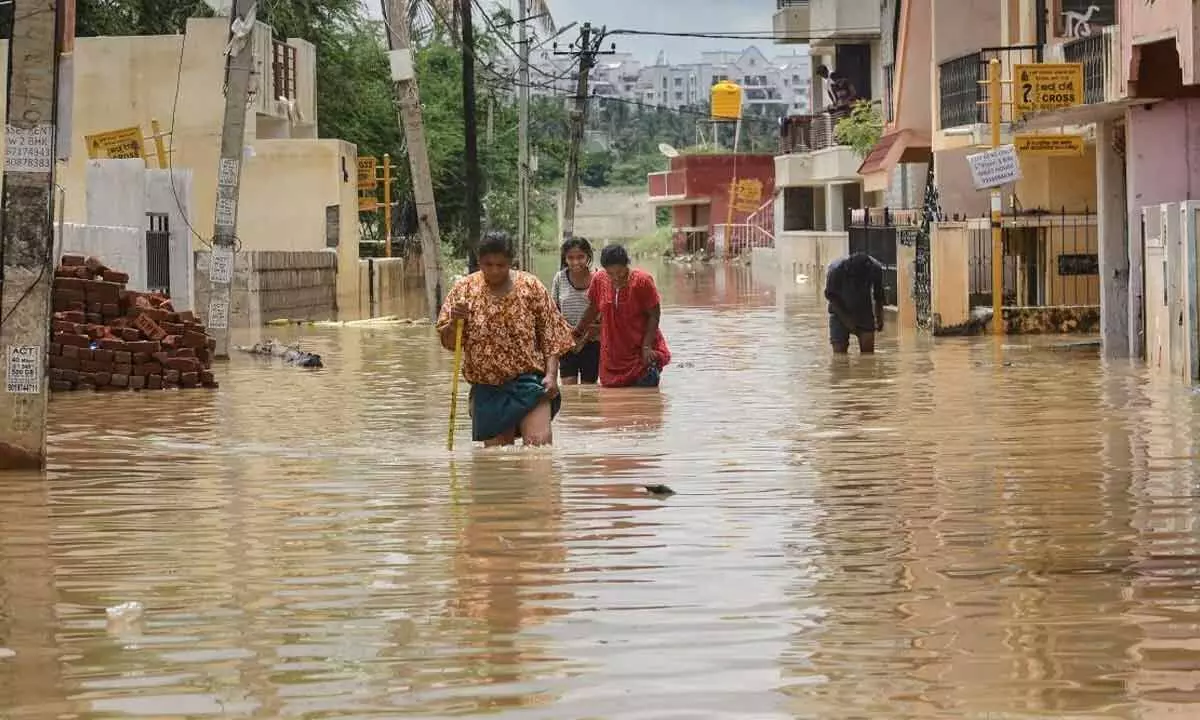Live
- Bihar: Four persons including girl injured in post bypolls violence in Gaya
- Dharmasthala Dharmadhikari Enters Record Book
- BJP to Review By-election Losses in State Meet
- Activist Alleges CPCB Cover-up on Endosulfan in Kasaragod
- Theft Case of Thumbe Mahalingeshwara Temple
- DIY vs professional car detailing: Pros and Cons
- Wild Elephant Gets Stuck at Rail Track Fence Forest Department Frees Animal
- CERT-In Issues Critical Security Alert for Apple Users: Update Your Devices Now
- Kolar’s Compassionate Leap: Mechanical Elephant Leads Temple Procession
- Centre to unveil startups under new National Quantum Mission guidelines
Just In
With lakes gone, Bengaluru shivers under showers


With lakes gone, Bengaluru shivers under showers
The Garden City, Silicon Valley of India, Summer Paradise are some of the epithets showered on Bengaluru.
Bengaluru: The Garden City, Silicon Valley of India, Summer Paradise are some of the epithets showered on Bengaluru. The city rightfully enjoyed all the titles as it once used to have plenty of lakes and its climate was pleasant apart from being the IT hub of the country. But sometime in the mid-80s due to corrupt political leaders the lakes and tanks were turned into residential layouts. These water bodies now are lying under millions of pillars and beds made of concrete and steel.
It is ironic also that India was one of the first nations to sign the first world agreement on water bodies and conservation, which was held in Iran's Ramsar in 1971. While the world continues to question whether the recommendations and declarations made at the Ramsar agreement are still relevant, India has assumed responsibility for continued conservation efforts of water bodies and wetlands via national and international conferences on water bodies. But for Bengaluru, none of that would help.
An article published in ENVIS it is stated that, "Urbanization entailed Bengaluru transforming broad swaths of land cover in conjunction with the rising concentration of the human population. The urbanised landscape offers its residents a complex social and economic context, resulting in a population increase."
Historically, Bangalore developed due to its favourable microclimate, water availability, and other natural advantages. Urbanization without planning resulted in chaotic growth, which altered the surrounding ecology, hydrology, and ecosystem.
The effects of urbanisation are increased pollution levels, inadequate infrastructure, and a dearth of fundamental utilities. This is evident in Bangalore with its severe water scarcity, frequent flooding, increased pollution levels, unfriendly buildings, and improper management of solid and liquid wastes, according to a scientific article published in the ENVIS report by the Indian Institute of Science. The article was written by a group of scientists led by Dr T V. Ramachandran of the Centre for Ecological Sciences at the IISc.
The article expresses concern about the effluent discharged into water bodies via trunk sewers and stormwater networks. Although the steady flow of sewage into aquatic bodies has helped maintain the water levels in the system of interconnected lakes, it has also contributed to the contamination of both surface and groundwater sources. According to experts, such situations make the protection of surface water sources more urgent. At the end of the 1970s Bengaluru had over 400 small, medium and water bodies out of which only 182 lakes and tanks remain but about 60 per cent of them have shrunk by half their size due to rampant encroachments.
The judicial committee constituted to go into the modalities of setting up a lake protection body under the leadership of Justice NK Patil in 2011 had observed that, "Generate funds through both revenue and non-revenue models in excess of what Bangalore actually spends in any given year. Bruhat Bangalore MahanagaraPalike and the Bangalore Development Authority must work together on this. The State government must establish a separate budget for the aforementioned objective." The second most affected location was the urban district of Bengaluru, which has 709 square kilometres of the dense urban area. "The difficulty in the urban district of Bengaluru was the rise of the urban area. More than a few inundated places were low-lying areas that were originally lakes or lake beds. These are the city's traditional watershed areas,"the committee had observed.
Koramangala's neighbourhood surrounding the KendriyaSadan apartments was a classic example. During heavy rains, the surplus water in the catchment regions further flooded the lowest point of the area, which was constructed on a former lakebed. The stormwater drains failed under the weight of the additional water and the entire area became flooded. This was the worst case of flooding in the metropolitan district of Bengaluru to date," say the engineers of the BBMP.

© 2024 Hyderabad Media House Limited/The Hans India. All rights reserved. Powered by hocalwire.com






